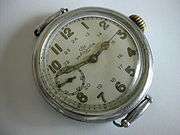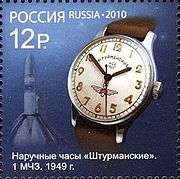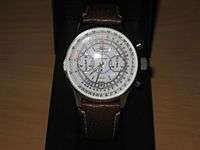Poljot


Poljot (Russian: Полет, literally meaning "flight"), is a brand of Soviet/Russian wristwatches, produced since 1964 by the First Moscow Watch Factory (Russian: Первый Московский Часовой Завод, ПМЧЗ, Perviy Moskovskiy Chasovoy Zavod). The flagship brand of the USSR's watch industry, Poljot produced numerous historical watches used in many important space missions, including the world's first space watch worn by Yuri Gagarin.
History



Founded in 1930 under orders from Joseph Stalin, the First State Watch Factory (Russian: Первый Государственный Часовой Завод - 1ГЧЗ) was the first large scale Soviet watch and mechanical movement manufacturer. Via its USA-based trading company Amtorg, the Soviet government bought the defunct Ansonia Clock Company of Brooklyn, New York in 1929, and the Dueber-Hampden Watch Company of Canton, Ohio. It moved twenty-eight freight cars full of machinery and parts from the USA to Moscow in order to establish the factory. Twenty-one former Dueber-Hampden watchmakers, engravers and various other technicians helped to train the Russian workers in the art of watchmaking as part of the Soviet's First Five-Year Plan. The movements of very-early products were still stamped "Dueber-Hampden, Canton, Ohio, USA" (examples of these watches are very collectible today). In 1935 the factory was named after the murdered Soviet official Sergei Kirov.
As the Germans closed in on Moscow in 1941, the factory was hurriedly evacuated to Zlatoust (Russian: Златоу́ст). By 1943 the Germans were in retreat, and the factory moved back to Moscow, adopting the "First Moscow Watch Factory" name (Russian: Первый Московский Часовой Завод - 1МЧЗ).
In 1947 the first wrist watches under the brand name "Pobeda" and the first Marine Chronometers and Deck watches are produced. By 1951 the production of wrist watches increases to 1.1 million. In 1975 new machinery and equipment for manufacturing complex watches are partly imported from Switzerland. The first chronograph "Okean" (caliber 3133) is produced for the space station "Sojuz-23."
In 1990 production of watches and clocks reaches 5 million pieces and in 1991 the international award "Golden Trophy for Quality" is awarded in Madrid.


PMChZ watches in Space
Gagarin's flight
On April 12, 1961 Yuri Gagarin became the first man in space. It is unclear what watch he wore during the first human space flight. Competing claims state that it was a Sturmanskie, a Pobeda or even a Rodina.[1][2] Today's owner of the brand Sturmanskie (Swiss company - Volmax, not PMChZ), is promoting the story that he wore a Sturmanskie that he got when graduating from his pilot school in 1957 in Orenburg, though this Sturmaskie model was distributed to graduating students only up to 1953. In 1993, another Gagarin space watch was sold by Sotheby's for 25,875 dollars. It was a "Rodina". Probably, the most reliable source of information is the Moscow Museum of Cosmonauts, and they display the watch he wore during his flight: a Pobeda[3]
1st space walk
In 1965 cosmonaut Alexei Leonov wore a FMWF Strela (transliteration of СТРЕЛА, which actually means "Arrow") chronograph during his historic first space walk, thus cementing Poljot's place in space history. As with Gagarin's first flight, Leonov's watch was not specially commissioned. The Strela replaced the Shturmanskie as the standard issue pilots watch. In the late 1970s, the Strela itself was replaced by a new breed of chronographs based around the (then new) 3133 movement (an original Russian movement similar in functionality to the Swiss Valjoux 7734, but with higher number of jewels 23 vs 17 and lever movement operating at 21,600 bph vs 18,000 bph). Poljot 3133-based watches continued where their predecessors left off and were taken into space by cosmonauts from Russia, France, Germany and Ukraine. On the wrist of cosmonaut Valeri Polyakov, a Poljot 3133-based watch set a space record for the longest space flight in history.
Current status

During the Soviet era, Soviet watch brands including Poljot, but also Raketa watches, were marketed in the United Kingdom under the brand "Sekonda". Today's Sekonda company, a British distributor of ubiquitous fashion watches, has no connection to any Russian watches. At the turn of the 21st century, the First Moscow Watch Factory began reproducing many of their most famous models as limited edition commemorative pieces. Replicas were made of the famous 1960s Shturmanskie worn by Yuri Gagarin, the 1940s Kirova pilots chronograph, and the 1970s Ocean (Океан) chronograph. All of the replicas became sought-after collectibles.
In late 2003, rumors predicting the demise of the Poljot brand circulated on the Internet. According to the rumors, the First Moscow Watch Factory was to cease producing their own models and become a source of inexpensive movements for other European watch brands. These rumors never came to fruition. Instead, in the late 2000s, the company was bought by the businessman Sergeï Pugachev, becoming one of the companies of his new luxury group, including: Hédiard, and the channel Luxe TV. The physical remnants of First Moscow Watch Factory were purchased by a group of former Poljot employees, forming the basis for a new company, Volmax. Volmax marketed watches under the Aviator, Buran, and Shturmanskie brands using movements produced by another Russian firm, MakTime.[4]
As of 2012, the status of the Poljot brand is unclear, though the brand appears to be moribund. MakTime, the company utilizing old Poljot equipment to manufacture mechanical movements, went bankrupt,[5] and Volmax, the successor company to First Moscow Watch Factory relocated to Switzerland.[6] Present models from the Volmax company are Swiss-made, using design cues from vintage Russian models.[7]
See also
- Raketa watch factory in Saint Petersburg, Russia
- Russian watches Pobeda
- Vostok Watch Makers, Inc
Notes
- ↑ http://www.rb.ru/blog/32137/chasy-gagarina-labirinty-istorii/1526744.html
- ↑ http://wap.german242.borda.ru/?1-9-0-00000079-000-10001-0
- ↑ http://www.kosmo-museum.ru/?locale=en
- ↑ http://www.russianwatchguide.com/volmax.htm
- ↑ http://forums.watchuseek.com/f10/no-more-poljot-movements-654408.html
- ↑ http://aviatorwatch.ch/retailers/
- ↑ http://aviatorwatch.ch/brand/
External links
| Wikimedia Commons has media related to Poljot. |
- Documentary: "The History of a Russian Watch Factory" (English) (Russian)
